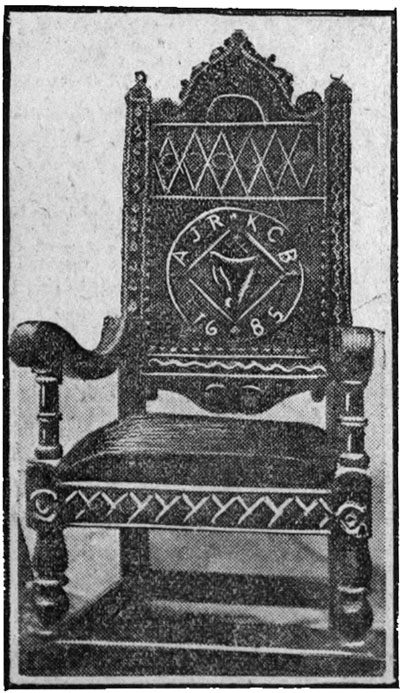Belfast Evening Telegraph, Wednesday, January 30, 1907
X -- Carrickfergus. -- St. Nicholas.
Jan 30 1907
It is a remarkable fact that Carrickfergus, having played such an important part in the history of the Empire, so little attention is paid to the county of the town by the present generation, one important encyclopaedia even dismissing it with an attenuated paragraph in which the landing of William III. is mentioned in conjunction with the later attempt by Thurot as the two events worth recording in its long history. The "Castle" is passed over with a word or two, yet according to Monsignor O'Laverty is it the only existing fortification in the kingdom which exhibits the characteristics of the old Norman military stronghold. Historians have not been able to settle definitely whether the place was granted to John de Courcey by Henry III. or to Hugh de Lacy by King John, who created his nominee Earl of Ulster in 1205, but one would readily expect that a town where wars had raged for about seven centuries would contain within its borders a very large collection of memorials to its illustrious dead. And yet it is practically destitute of anything remarkable in the way of monuments or tombstones. The reason is probably that in the old days the people were buried inside the walls of the ancient church so that the graveyard which has grown up round the town clock on the tall steeple is modern compared with the history of the district.
The Castle indeed might be considered an important necropolis in itself, for there, as the rumblings of the petty wars kept cannonading down the centuries, were buried the hopes of many an ambitious invader, or many in legendary literature that away in the dim distance of the past King Fergus of Scotland came to the Castle to drink, and was drowned in the well, his body afterwards being taken to Monkstown. From this the place takes its name. "The Rock of Fergus." Robert Bruce at one time besieged the Castle and forced the garrison to surrender. Very few years passed indeed during which the fortress did not change hands.
One of the chancel chairs in St. Nicholas's Church -- date, 1685. The history of the chair is lost, but it is probably one of the finest samples of seventeenth century wood-carving at present in existence.

And in sympathy with the other parts of the town the church seems to have also exhibited a desire for change. It was mentioned in the Taxation of Pope Nicholas and probably belonged to the Franciscan Friars who were early established in the town. Reginald, Bishop of Connor, mentions it in a letter to Henry III. in 1220, in which he states that --
"Among other valuable endowments conferred on the Abbot and Canons of St. Mary's, Carrickfergus, by the munificence of John de Courcey was the rectory of St. Nicholas, which then one Andeon Brun, a clergyman, had unlawfully possessed himself of."
It is inside the church, therefore, that we must look for anything suitable for our purpose, and there we could find much more than we have space for in a short article. If the earlier inhabitants of the town have been careless regarding the memorials of the dead anything they have bequeathed to the present generation has been and is most carefully preserved. The hall at the vestry-room contains several exceedingly interesting relics. On one side there is an old gable cross which was dug up from the floor of the chancel below the able in 1740 and which bears clearly the date 1164, while mounted on a wooden baton in the othercorner quietly rest a cannon-ball which was fired into the tower by the Duke of Schomberg's army during the siege of 1689.
As we enter the church it is shrouded in those ecclesiastical shadows which were a feature of the ancient edifices in the days when people did not require prayer-books to fit the waistcoat-pocket. The heavy stained-glass windows, with their elongated frames of lace-like masonry add to the mysterious atmosphere which fills the grand old building.
Passing the Chancel we notion a beautifully-carved oak chair bearing the date 1685 on a circular belt or scroll, which also carries what is to me a strange array of letters, "A. J. R., K. C. B.," and in the centre of the circle there is carved an Irish harp, surmounted by a compass and square.
"The Belfast people would like to take that from us," remarks my guide -- one of the most intelligent sextons I have met -- a man who takes an interest in his occupation and position, and who knows most of the features of the establishment thoroughly.
As we reach the body of the cruciform -- the design of the building -- I look to my right and there behold a magnificent memorial erected by the Chichester family. Sir Arthur Chichester, the Lord Deputy and Lord Treasurer of Ireland, together with many members of the family are interred in the north aisle, and this memorial represents the life-size kneeling figures of Sir Arthur and Lady Chichester, while on a cushion rests the heir; but this history is too well known to bear rehearsing here. I am in search of memorials, the very existence of which may induce my readers to study history for themselves.
Beside the pulpit lies a lid, which is supposed to have covered an ancient stone coffin 700 years ago, and the font close by is over 200 years old.
In the opposite wall a narrow niche is pointed out to me. This is "the lepers' window," outside which in the old days those suffering from the dread disease were permitted to stand and listen to the service being conducted inside.
Here is a table to the memory of
Thomas Cooper
Mayor of
Carrickfergus
1623
and here one of the finest specimens of the early stained glass work. Indeed, the church contains several fine examples. The piece to which I rever is said to have been the old east window, and represents the baptism of Christ by John, and the date is given as 1306. Another tablet announces that
Here lyeth ye Body
of Richard Lang
who departed this life
ye 20th of May
1620. Here also lyeth
ye body of James
Lang who departed
1657
Then comes
Also his wife"
but although she was the worthy daughter of "John Bulworthy, Alderman and twice Lord Mayor of Carrickfergus", I entirely failed to gather from the inscription to which the Langs she really was wife. This uncertainty is a special feature of ancient stones, and the compilers of the wording seldom trouble about the context so long as the text conveys their immediate intention.
Away back in 1714 Samuel Davys, Alderman, presented Font, silver flagon and several other articles to the congregation, and these are still in use, while the donation is recorded by the tablet fixed in the wall. Just opposite there is another record of the progress of the early church.
"This worke was begun in 1614
by Mr. Cooper, then Mayor, and
wrought by Thomas Paps, [-?-]
mason, Mr. Openshawe being
parson.
Viat. Rex Iacobus.
We climb the staircase to the small gallery, and are pointed out the arms of James I. above the doorway, while at the other end of the church we saw the arms of the "county of the town."
Until about thirty years ago the flags of the different regiments connected with the history of the town hung in the old church, but these have been removed, and many of the tombstones which floored the aisles have been taken up to make way for the more fantastic tiling. Four of the principal stones have been taken outside, and although some of them were quite well preserved after two hundred years within the building, their short sojourn in the open air has had a serious effect on them already. One stone belongs to the Gardner family, which was prominently identified with the place at the end of the seventeenth century; another had covered the remains of Rev. Hill Benton, who was Dean of Connor, and died in 1775; while the owner of a third boasts of "being descended from a branch of the ancient family of Gusanna in North Wales." Out in the ground there is nothing of special note, but one may be forgiven for asking why in the case of several military men who are interred there is the word "Esqr." Added?
But with all this information at our command there are very few relics directly connected with those exciting events in the history of Ulster in which Carrickfergus as always been the centrepiece.
Among the modern monuments perhaps the most important is that belonging to the Craigs, of Sco--- Bush. Had not my present [--?--] been with the dead rather than the living I could have written quite an interesting romance around the personality and adventures of the present representative of the family, who is doing and has done so much for the benefit of his native

